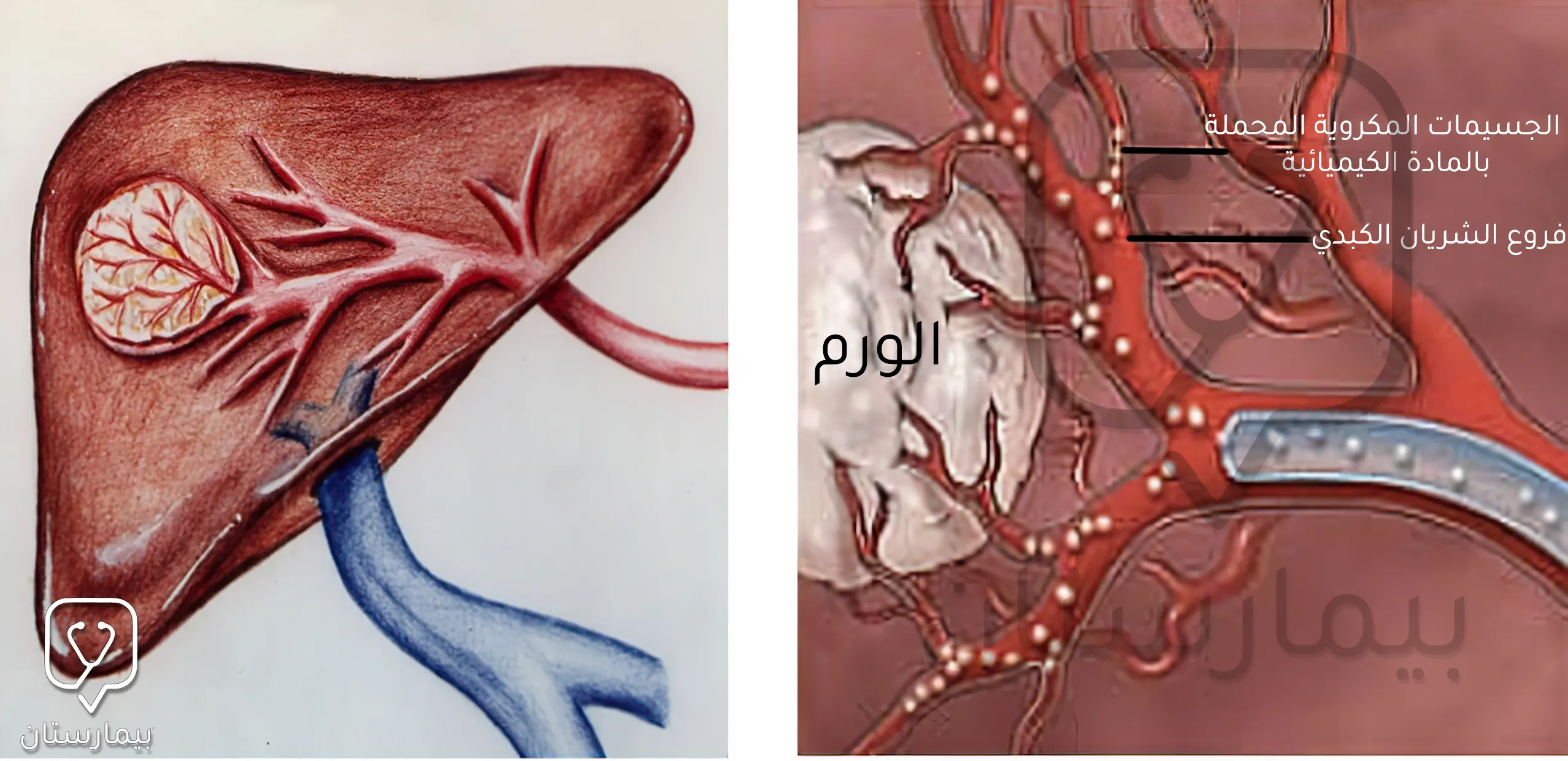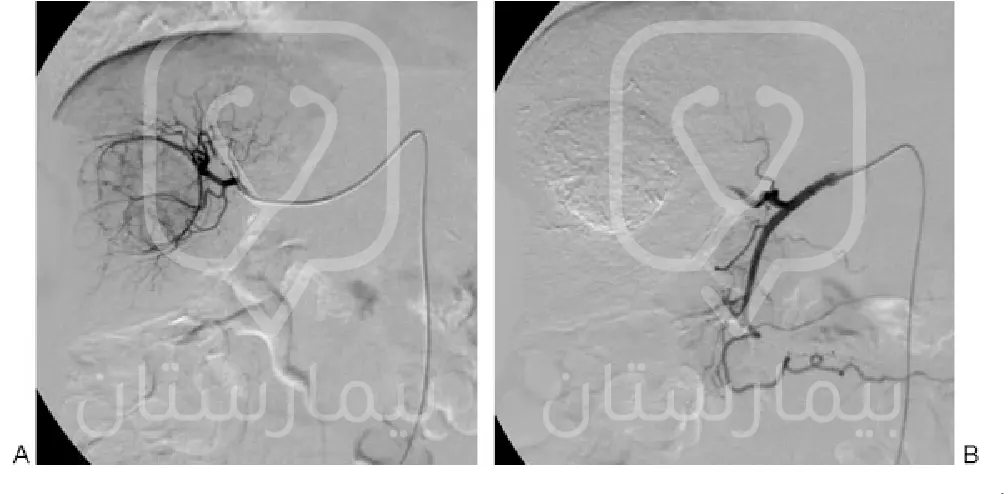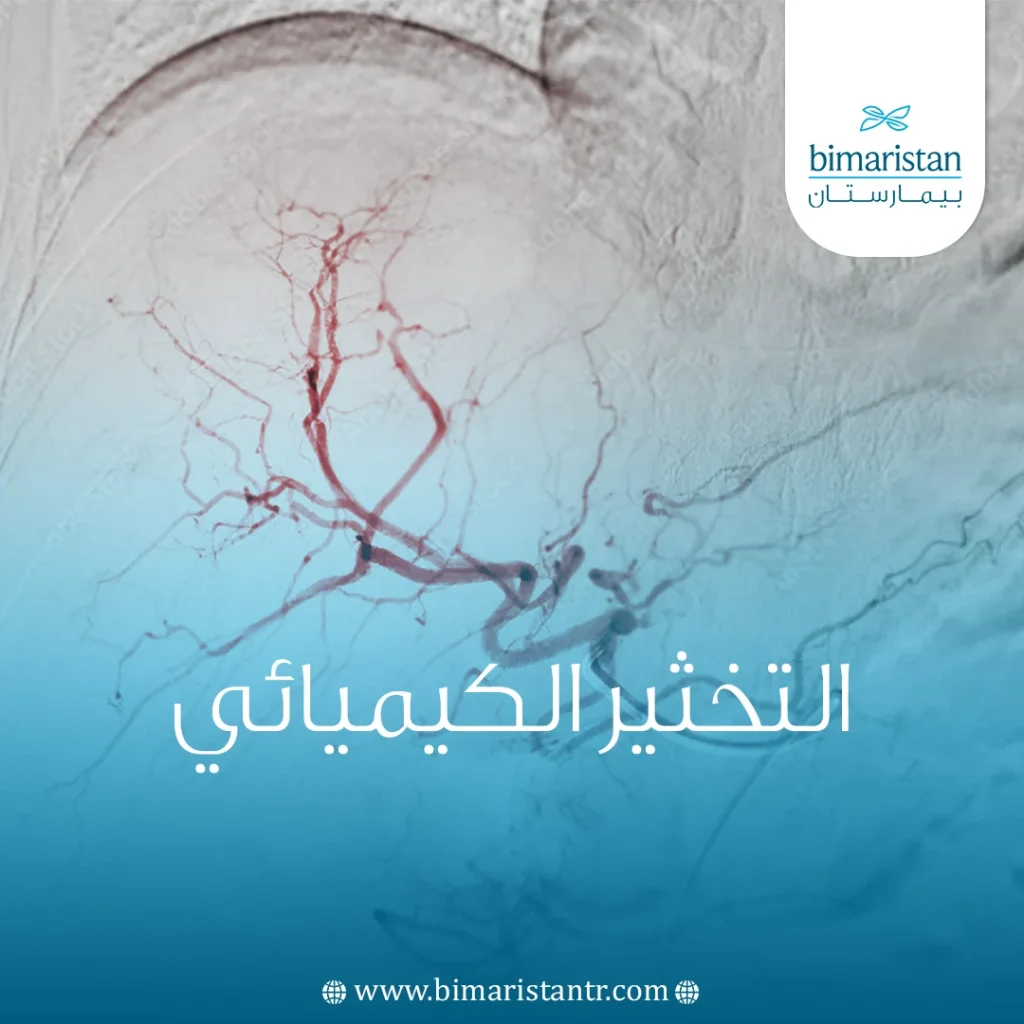التخثير الكيميائي Chemoembolization هو من أحدث الطرق العلاجية ذات الأعراض الجانبية الطفيفة، وهذه الطريقة شهدت قفزات نوعية في تركيا لكفاءة الأطباء والأجهزة فيها. أو مايعرف بالعلاج الكيميائي الموجه مع التخثير.
ما هو التخثير الكيميائي Chemoembolization؟
التخثير الكيميائي Chemoembolization (طريقة تستخدم في العلاج الكيميائي Chemoembolization) أو ما يدعى بالتخثير الكيميائي عبر الشريان (Transarterial Chemoembolization (TACE هو نوع من أنواع العلاج الكيميائي والطرق العلاجية (أو التسكينية) الحديثة تضم كل من العلاج الكيميائي Chemotherapy والتخثير للتخفيف من أعراض الورم وتصغيره عبر قتل الخلايا الورمية، وبشكل مشابه للتخثير الشعاعي Radioembolization (العلاج بالأشعة التداخلية Interventional Treatment) إلا أن الاختلاف هنا أننا نحقن مواد كيميائية قاتلة للخلايا السرطانية عوضاً عن جزيئات صغيرة محملة بنظائر مشعة، وهذه الطريقة الكيميائية Chemotherapy غالباً ما تستخدم في علاج سرطانات الكبد (Hepatocellular cancer (HCC سواءً كانت بدئية (أي أنها نشأت في الكبد) أو أنها انتقلت إليه من أعضاء أخرى.

تعد عملية التخثير الكيماوي عملية طفيفة التوغل وهي تجرى على يد أخصائي أشعة وتشبه تقريباً تصوير الأوعية من ناحية الآلية.
يتم التخثير (الإصمام) Embolization عبر حقن مواد انصمامية تقوم بسد الأوعية الدموية المغذية للورم، ومنع انتشار التأثير الكيمياوي Chemotherapy إلى مناطق أخرى.
يمكن أن نستخدم العلاج بالتخثير الكيمياوي Chemoembolization لوحده أو أننا نشركه مع علاجات أخرى كالعلاج الشعاعي حيث أثبتت الدراسات تحسن البقيا لدى مرضى سرطانة الخلية الكبدية حين دمج العلاج الشعاعي مع Chemoembolization، أو كالعلاج الكيميائي Chemotherapy أو التدمير بالأمواج الراديوية Radiofrequency Ablation…
ما هي ميزات العلاج بالتخثير الكيمياوي Chemoembolization؟
تملك هذه الطريقة Chemoembolization ميزات عدة مما يمزها عن طرق العلاج الأخرى الاعتيادية للعلاج ومن هذه الميزات:
- تمنع وصول الأوكسجين المحمل في الدم إلى الورم، مما يساهم في تقليص حجم الورم وقتل خلايا السرطان Cancer.
- نظراً لكون الجرعة الكيميائية ستحقن مباشرة في الورم، يمكن إعطاء جرعة أكبر من الدواء الكيميائي Chemotherapy في التخثير الكيمائي Chemoembolization من الجرعة المستخدمة في العلاج الكيمياوي الاعتيادي Standard chemotherapy.
- إن تخثر دم الشريان Arterial Blood وقطع التروية عن السرطان Cancer المجرى في هذه العملية يمنع انتشار الدواء الكيماوي إلى المناطق المجاورة.
- الأعراض في هذا العلاج الكيميائي Chemotherapy أقل وأخف بشكل ملحوظ بسبب ما ذكرنا سابقاً.
متى نستخدم التخثير الكيميائي Chemoembolization عبر الشريان TACE؟
غالباً ما يلجأ الأطباء لهذه الطريقة عند فشل الطرق الأخرى أو أن المرضى patients يعانون من حالة لا تسمح لهم بالخضوع لعلاجات أكثر قسوة (كالجراحة).
يعتبر التخثير الكيميائي Chemoembolization أكثر فائدة للمرضى الذين يقتصر مرضهم في الغالب على الكبد Liver، سواء بدأ الورم فيه أو انتشر إليه (السرطان النقائلي) من عضو آخر.
تشمل السرطانات التي يمكن علاجها عن طريق التخثر الكيميائي Chemoembolization ما يلي:
- الورم الكبدي أو سرطان داخل الخلايا الكبدية Hepatocellular Carcinoma
- سرطان القنوات الصفراوية
- بعض السرطانات التي تعطي نقائل كبدية Hepatic:
- سرطان القولون
- سرطان الثدي
- الأورام الكارسينوئيدية وأورام الغدد الصم العصبية الأخرى
- أورام الجزر البنكرياسية
- الورم الميلانيني في المقلة
كيف يجهز المرضى للتخثير الكيميائي Chemoembolization في تركيا؟
يوصي طبيب العملية بإجراء عدة اختبارات، بما في ذلك اختبارات الدموية واختبارات وظائف الكبد، كما يمكن إجراء التصوير المقطعي المحوسب CT scan أو التصوير بالرنين المغناطيسي MRI للكبد قبل إجراء عملية تخثر الدم الكيميائي Chemoembolization.
يصف الطبيب بعض الأدوية المهدئة كما يقوم بإيقاف أي دواء يأخذه المريض قد يتعارض مع العملية (ومنها الأسبرين).
بعد ظهور نتائج الفحوصات يجب على الطبيب التأكد من عدم وجود أي انسداد في الجريان الدموي الكبدي (انسداد وريد الباب) أو وجود تشمع في الكبد أو أي انسداد في الطرق الصفراوية.
سيُطلب من المريض التوقف عن الأكل أو الشرب بعد منتصف الليل في الليلة السابقة لـ العلاج بعملية التخثير الكيماوي Chemoembolization، يمكث المرضى عادة في المستشفى من 1-4 ليالٍ بعد العملية، وتجرى العملية من قبل أخصائي الأشعة التداخلية في قسم الأشعة التداخلية، سيفتح للمريض خط وريدي، ويعطى عبره السوائل الوريدية والمضادات الحيوية والأدوية المهدئة.
كيف تجرى عملية التخثير الكيميائي (Chemoembolization (TACE في تركيا؟
في العلاج ب تخثر (الانصمام) الدم الكيميائى Chemoembolization في تركيا ستتضافر جهود أفضل الأطباء مع نخبة الممرضات وأفضل الأجهزة الطبية الحديثة لتسير عملية العلاج الكيميائي Chemotherapy المقرون ب تخثر الدم الموضعى Chemo embolization بأفضل صورة وتحقيق أفضل النتائج بأقل كلفة ممكنة، حيث يبقى مركز بيمارستان الطبي هو خيارك الأول للعلاج في تركيا.
سيتم التقاط صور بالأشعة السينية لرسم خريطة لمسار الأوعية الدموية التي تغذي الورم، قد يتم إعطاء المريض دواء يسمى الوبيورينول، والذي يساعد في حماية الكليتين من العلاج الكيميائي Chemotherapy والمنتجات الثانوية التي تنتجها خلايا الورم المحتضرة.
سيضع أخصائي الأشعة التداخلية قسطرة صغيرة (أنبوب صغير Transcatheter) في أحد شرايين الفخذ ويقوم بإجراء مخطط للشرايين Arterial Gram لفحص الشرايين في الكبد على وجه التحديد.
قد يستخدم الطبيب في عمليّة الانصمام (التخثر) الكيميائي Chemoembolization التخدير الموضعي، ولا تتطلب عملية الانصمام (تخثُّر الدم) الكيميائي Chemoembolization تنبيب المريض، ومع ذلك، قد يحتاج بعض المرضى إلى تخدير عام ولا يُكتفى بالتخدير الموضعى.
سيقوم الطبيب بعمل شق جلدي صغير جداً في الموقع.
باستخدام توجيه الأشعة السينية، يدخل الطبيب قسطرة رفيعة عبر الجلد إلى المسار الشرياني Arterial، إما في الفخذ أو في الرسغ، ثم يدفعها إلى الكبد، يتم حقن injecting مادة التباين بواسطة القسطرة ويتم أخذ سلسلة أخرى من الصور بالأشعة السينية.
بمجرد وضع القسطرة في فروع الشريان Arterial Branches الذي يغذي الورم، يتم خلط الأدوية المضادة للسرطان وعوامل الاصمام معاً وحقنها.

سيتم أخذ صور أشعة سينية إضافية للتأكد من وصول العلاج الكيميائى Chemotherapy للسرطان Cancer و تخثر الطريق الشريانى للسرطان Cancer بالكامل.
عند اكتمال الإجراء، يقوم الطبيب بإزالة القسطرة والضغط لإيقاف أي نزف، في بعض الأحيان، قد يستخدم الدكتور جهاز إغلاق لسد الفتحة الصغيرة في مكان دخول القثطار، سيسمح لك ذلك بالشفاء بسرعة أكبر، لا توجد أي غرز ظاهرة على الجلد.
قد يوفر لك طبيبك أدوية للمساعدة في منع الغثيان والألم والمضادات الحيوية للمساعدة في منع العدوى والإنتان بعد العملية.يتوقع أن يخرج المريض من غرفة العمليات بعد العلاج بواسطة تخثر الدم الك بعد 6 ساعات تبعاً للشريان الذي اُستخدم.
إن التخثير الكيميائي Chemoembolization عملية جديدة نوعاً ما، فإن كان لديك أي استفسار عن هذه العملية بإمكانم التواصل معنا لأخذ المعلومات حول كل ما تود معرفته حول هذا العلاج، مركز بيمارستان عائلتك في تركيا.
المضاعفات والآثار الجانبية ل التخثر الكيميائي (Chemoembolization (TACE
بعد الإجراء، قد يكون لدى المرضى Patients درجات متفاوتة من الألم والحمى والغثيان، قد تستمر هذه الأعراض من بضع ساعات إلى بضعة أيام، ويمكن علاجها بسهولة حيث يصف طبيب العملية أدوية تساعد على التخلص من هذه الأعراض، قد يلاحظ المريض أيضا تساقطا طفيفا للشعر، نادرا ما يلاحظ عند اي شخص آخر.
من النادر حدوث مضاعفات خطيرة من الانصمام الكيميائي Chemoembolization (التخثر الكيمياوي Chemo).
في أقل من 3٪ من الإجراءات، قد يصاب مكان السرطان Cancer الذي عولج بالتخثير الكيميائي Chemoembolization نتيجة الإجراء بالعدوى ويمكن أن يتشكل خراج.
سجلت حالة واحدة للفشل الكبدي بسبب العلاج ب تخثر الدم الكيميائي عبر الطريق الشريانى (Arterial Chemoembolization (TACE من بين 100 عمليّة جراحية.
الرعاية بعد العلاج بعملية الاصمام (تخثُّر الدم) الكيميائي Chemoembolization في تركيا
يجب أن يكون المريض قادرا على استئناف أنشطته اليومية الاعتيادية في غضون أسبوع من العلاج بعملية التخثير الكيميائي Chemoembolization في تركيا.
خلال الشهر الأول الذي يلي العلاج الكيميائي Chemotherapy المترافق بالعلاج ب الانصمام الكيميائي عبر الشريان Arterial Chemoembolization، يجب على المريض مراجعة الطبيب بشكل روتيني وإعلامه بأية مشاكل ومتابعة مدى تقدم شفائه.
ربما يحتاج لإجراء فحص بالأشعة المقطعية أو التصوير بالرنين المغناطيسي واختبارات الدم لتحديد حجم وحالة السرطان Cancer المعالج.
ينقسم الكبد إلى قسمين الفص الكبدي الأيمن والفص الكبدي الأيسر، إذا كان هناك ورم يشمل كلا الفصين، فعادةً ما يتم علاج ذلك بطريقة مرحلية، أثناء الإعداد الأول، يتم علاج أحد الفصوص، يُعالج الفص الثاني عادةً بعد شهر تقريبا.
ينصح بإجراء التصوير المقطعي المحوسب أو التصوير بالرنين المغناطيسي كل ثلاثة أشهر بعد ذلك لتحديد مدى تقلص السرطان Cancer، ولمعرفة ما إذا كانت هناك أورام جديدة تظهر في الكبد.
متوسط الوقت قبل الجولة الثانية من العلاج ب Chemoembolization TACE (بسبب ورم جديد) ما بين 10 و14 شهرًا.
يمكن تكرار العلاج ب TACE Chemoembolization عدة مرات على مدار سنوات عديدة، طالما أنه لا يزال ممكنا تقنيا المريض بصحة جيدة بما يكفي لتحمل الإجراءات المتكررة.
